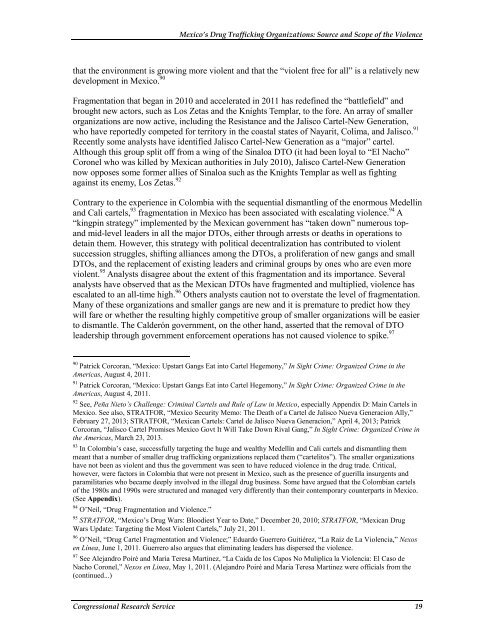Mexico's Drug Trafficking Organizations - Federation of American ...
Mexico's Drug Trafficking Organizations - Federation of American ...
Mexico's Drug Trafficking Organizations - Federation of American ...
Create successful ePaper yourself
Turn your PDF publications into a flip-book with our unique Google optimized e-Paper software.
Mexico’s <strong>Drug</strong> <strong>Trafficking</strong> <strong>Organizations</strong>: Source and Scope <strong>of</strong> the Violence<br />
that the environment is growing more violent and that the “violent free for all” is a relatively new<br />
development in Mexico. 90<br />
Fragmentation that began in 2010 and accelerated in 2011 has redefined the “battlefield” and<br />
brought new actors, such as Los Zetas and the Knights Templar, to the fore. An array <strong>of</strong> smaller<br />
organizations are now active, including the Resistance and the Jalisco Cartel-New Generation,<br />
who have reportedly competed for territory in the coastal states <strong>of</strong> Nayarit, Colima, and Jalisco. 91<br />
Recently some analysts have identified Jalisco Cartel-New Generation as a “major” cartel.<br />
Although this group split <strong>of</strong>f from a wing <strong>of</strong> the Sinaloa DTO (it had been loyal to “El Nacho”<br />
Coronel who was killed by Mexican authorities in July 2010), Jalisco Cartel-New Generation<br />
now opposes some former allies <strong>of</strong> Sinaloa such as the Knights Templar as well as fighting<br />
against its enemy, Los Zetas. 92<br />
Contrary to the experience in Colombia with the sequential dismantling <strong>of</strong> the enormous Medellin<br />
and Cali cartels, 93 fragmentation in Mexico has been associated with escalating violence. 94 A<br />
“kingpin strategy” implemented by the Mexican government has “taken down” numerous topand<br />
mid-level leaders in all the major DTOs, either through arrests or deaths in operations to<br />
detain them. However, this strategy with political decentralization has contributed to violent<br />
succession struggles, shifting alliances among the DTOs, a proliferation <strong>of</strong> new gangs and small<br />
DTOs, and the replacement <strong>of</strong> existing leaders and criminal groups by ones who are even more<br />
violent. 95 Analysts disagree about the extent <strong>of</strong> this fragmentation and its importance. Several<br />
analysts have observed that as the Mexican DTOs have fragmented and multiplied, violence has<br />
escalated to an all-time high. 96 Others analysts caution not to overstate the level <strong>of</strong> fragmentation.<br />
Many <strong>of</strong> these organizations and smaller gangs are new and it is premature to predict how they<br />
will fare or whether the resulting highly competitive group <strong>of</strong> smaller organizations will be easier<br />
to dismantle. The Calderón government, on the other hand, asserted that the removal <strong>of</strong> DTO<br />
leadership through government enforcement operations has not caused violence to spike. 97<br />
90 Patrick Corcoran, “Mexico: Upstart Gangs Eat into Cartel Hegemony,” In Sight Crime: Organized Crime in the<br />
Americas, August 4, 2011.<br />
91 Patrick Corcoran, “Mexico: Upstart Gangs Eat into Cartel Hegemony,” In Sight Crime: Organized Crime in the<br />
Americas, August 4, 2011.<br />
92 See, Peña Nieto’s Challenge: Criminal Cartels and Rule <strong>of</strong> Law in Mexico, especially Appendix D: Main Cartels in<br />
Mexico. See also, STRATFOR, “Mexico Security Memo: The Death <strong>of</strong> a Cartel de Jalisco Nueva Generacion Ally,”<br />
February 27, 2013; STRATFOR, “Mexican Cartels: Cartel de Jalisco Nueva Generacion,” April 4, 2013; Patrick<br />
Corcoran, “Jalisco Cartel Promises Mexico Govt It Will Take Down Rival Gang,” In Sight Crime: Organized Crime in<br />
the Americas, March 23, 2013.<br />
93 In Colombia’s case, successfully targeting the huge and wealthy Medellín and Cali cartels and dismantling them<br />
meant that a number <strong>of</strong> smaller drug trafficking organizations replaced them (“cartelitos”). The smaller organizations<br />
have not been as violent and thus the government was seen to have reduced violence in the drug trade. Critical,<br />
however, were factors in Colombia that were not present in Mexico, such as the presence <strong>of</strong> guerilla insurgents and<br />
paramilitaries who became deeply involved in the illegal drug business. Some have argued that the Colombian cartels<br />
<strong>of</strong> the 1980s and 1990s were structured and managed very differently than their contemporary counterparts in Mexico.<br />
(See Appendix).<br />
94 O’Neil, “<strong>Drug</strong> Fragmentation and Violence.”<br />
95 STRATFOR, “Mexico’s <strong>Drug</strong> Wars: Bloodiest Year to Date,” December 20, 2010; STRATFOR, “Mexican <strong>Drug</strong><br />
Wars Update: Targeting the Most Violent Cartels,” July 21, 2011.<br />
96 O’Neil, “<strong>Drug</strong> Cartel Fragmentation and Violence;” Eduardo Guerrero Guitiérez, “La Raiz de La Violencia,” Nexos<br />
en Línea, June 1, 2011. Guerrero also argues that eliminating leaders has dispersed the violence.<br />
97 See Alejandro Poiré and Maria Teresa Martinez, “La Caida de los Capos No Muliplica la Violencia: El Caso de<br />
Nacho Coronel,” Nexos en Linea, May 1, 2011. (Alejandro Poiré and Maria Teresa Martinez were <strong>of</strong>ficials from the<br />
(continued...)<br />
Congressional Research Service 19















